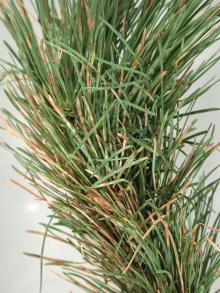Cause The fungus Rhabdocline laricis (formerly Meria laricis) overwinters in fallen needles and dead terminal tufts of needles that adhere to seedlings. Spores are produced in the spring as new foliage is produced. Young juvenile tissues are most susceptible to infection. Wet spring weather favors the disease.
Symptoms Yellow to brown spots arise on any needle surface and enlarge to cover the entire needle. Brown needles wither and fall early in the growing season. Mature trees don't die but have reduced growth rates. Seedlings may be defoliated and killed in the nursery. Symptoms may seem to occur very suddenly and may be confused with frost damage. Severely infected stands have a brown, scorched appearance due to the persistence of the infected needles.
Cultural control
- Remove and destroy fallen needles.
Reference McBride, R.P. 1971. Micro-organism interactions in the phyllosphere of Larch. Ecology of leaf surface micro-organisms. Pages 545-555.

